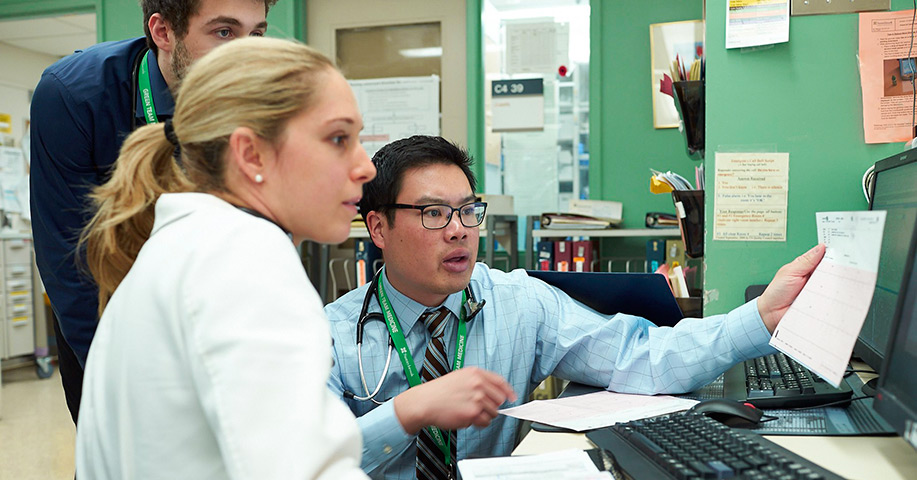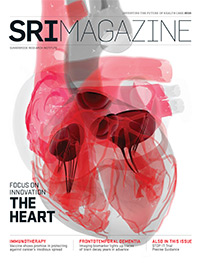Always Connect
Systematic approach to communication during patient care handover best: study

First-year resident Dr. Danielle Hammond (left) reviews patient charts with Dr. Brian Wong (right).
Photo: Nation Wong
The morning handover of patient care, whereby patient information and clinical responsibility are transferred through spoken and written communication between physicians and medical teams at the start of a shift, is a vulnerable time for patient safety. There is a perception among health care practitioners that trainees, encompassing medical students and residents, make it even riskier because they sometimes fail to communicate pertinent information. In part, this is viewed as being attributable to an overall reduction in resident duty hours, which has led to more handovers.
Few studies have looked at the quality and interaction of the morning handover at the end of an overnight shift. Given this paucity of evidence, Dr. Brian Wong, an associate scientist in the Veterans Research Program at Sunnybrook Research Institute, co-led a study that assessed how frequently the overnight on-call trainee would convey clinically relevant patient issues to the daytime team. The aim was to identify factors that led to omissions in verbal handover of overnight on-call issues.
The researchers observed 26 morning handovers on the general internal medicine wards at Sunnybrook and Toronto Western Hospital. Participants were on-call third-year medical students and first- and second-year residents. Teams included one attending physician, one senior resident, at least two interns and two medical students. Each was responsible for 15 to 30 patients per day.
Of the 141 cases analyzed, Wong found that the on-call trainee omitted 40% of clinically important issues during the handover and did not document information in the patient's medical record for 86% of the issues. Only 14% of these issues had a progress note from the on-call trainee in the chart. Results were published in JAMA Internal Medicine.
"What became apparent was the handover processes are very variable. There's little consistency across the teams,” says Wong, who is also an assistant professor at the University of Toronto. “It’s a chaotic time because it’s the start of the day, so people are constantly being interrupted and asked to take care of other problems. It’s disruptive when you’re trying to have a conversation as a team.”
The groups used three main approaches to talk about the overnight issues during morning handover. The first, used 63% of the time, involved the team discussing each patient one by one, guided by a written list. The second, used 22% of the time, entailed giving the resident a single opportunity to delegate issues. The third was conveying information to a senior-level team member; it was used 15% of the time.
“We found in those instances when the teams were more systematic [that] if they went through every single patient, it was more likely that the information would be conveyed back to the team,” says Wong about the list approach, which had the fewest omissions.
Wong says failure to communicate and document information could cause unnecessary delays and a lack of follow-up to address important issues.
“There is a strong belief that many patient safety problems are rooted in communication-type problems,” he says. “If we can improve our communication practices, there's a chance that we can improve safety for patients.”
— By Eleni Kanavas




